#gender disparities in film industry
Text
Filmmaker Alankrita Shrivastava spotlights gender disparities in film industry at IIFTC; calls for equality in budget allocation for female-centric films
Prominent filmmaker Alankrita Shrivastava has drawn attention to the persisting gender disparities in the film industry while speaking at 10th edition of the India International Foreign Tourism Conclave (IIFTC). She highlighted prevailing bias against female-centric films in the industry.
Shrivastava is known for her work such as “Lipstick Under My Burkha”, “Made in Heaven”, and “Bombay Begums”.…

View On WordPress
#Entertainment#Female Centric film#film#Gender Based Films#gender disparities in film industry#IIFTC#movie
0 notes
Text
« Known globally for highly stylized genre films depicting the gritty underbelly of society with brutal violence and crimes, South Korean cinema was long characterized by what one film critic famously called “dark blue filter thrillers” mostly made by and starring men. If women appeared at all, it was often as one-dimensional clichés, serving as plot devices like a femme fatale, a murder or rape victim, an innocent lover or wife, or a self-sacrificing mother.
To challenge this norm and support women filmmakers, some women started to not only watch female-driven films but also buy more tickets than they could even use for such movies in a campaign called “spirit-sending”— meaning they would be at the theaters in spirit. The campaign turned a surefire box-office disaster to an award-winning hit, saving the career of a rare female director.
“It was truly a miracle,” Lee Ji-Won said of Miss Baek, her 2018 debut film about a female former convict trying to save a little girl from abusive parents. The drama, which portrays the friendship between two abuse survivors, was such a rarity in an industry dominated by what Lee called “films with cops, gangsters, naked women, or rom-coms” that it was snubbed by almost all investors and distributors. One investor promised to fund it only if Lee changed the lead character to a man. Another bet that “the disaster-in-waiting” would perish in cinemas in a week—a warning that almost materialized, as the film’s opening-day sales were so poor that it was projected to sell less than a quarter of the tickets required just to break even.
“Everybody, myself included, was so sure that the movie would crash and burn, and my career was over—until weird things started to happen on social media,” Lee told me.
Impressed by the rare women-led film with complex female characters, made by an even rarer woman director, many women watched it again and again, buying tickets even when they couldn’t attend. Ticket sales rebounded sharply as #SendingSpirit became a viral hashtag that continued for months until the film broke even. Miss Baek eventually won rave reviews and swept major awards, and the same investors who’d once snubbed Lee began to court her, begging to see her scripts.
“The gesture of solidarity by all these women was just overwhelming,” Lee said, wiping away tears. “They, like me, were so thirsty for movies portraying women as complex, multidimensional human beings.” In 2021, she finished shooting her second movie, featuring some of the country’s biggest stars.
The “spirit-sending” campaign lived on to drive the success of other
women-led movies, like the film adaptation of Kim Ji-Young, Born 1982, allowing such films to defy the boycott campaigns that often targeted “feminism-stained movies.” While the film was hit by thousands of 0 percent ratings even before its official release (causing a vast gender disparity in its ratings on the top web portal—2.99 among men and 9.45 among women), Kim Ji-Young eventually became a hit watched by millions at home. Female-driven movies have grown in numbers and ticket sales since, led by a new generation of filmmakers like Lee and some male filmmakers as well. »
— Hawon Jung, Flowers of Fire: The Inside Story of South Korea's Feminist Movement
108 notes
·
View notes
Text
Burlesque in Expression
Christina Aguilera - Express (Burlesque)
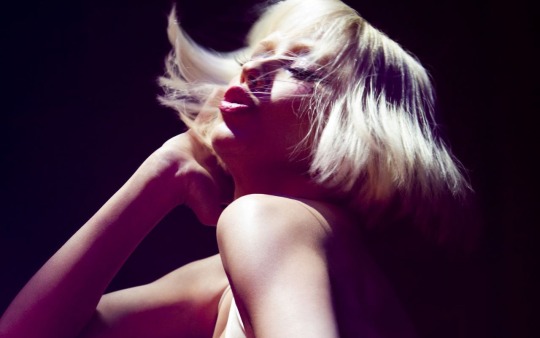
How is the film related to the social context of the country during production?
When the musical Burlesque was released in 2010 the United States was still recovering from the financial crisis of 2008. This global economic downturn significantly impacted various industries, even the entertainment business, which suffered from the rapid decline of consumer spending. Burlesque's central narrative is rooted in themes of chasing dreams and finding success despite difficult circumstances which naturally resonated with audiences when the film was released. Along with this, the emphasis of female empowerment and solidarity grew even more culturally significant in 2010 when the discussion surrounding gender equality and women’s rights was rapidly gaining momentum. The establishment of International Women's Day and the creation of the global UN Women's Agency occurred in 2010 during this heightened period of global activism. Burlesque’s main character Ali leaves her small-town life behind to chase her dreams of becoming a star in Los Angeles. Her relationships with the other female characters in the film are ones of sisterhood and community even after feuds and rivalries because the community is a grounding force in the performances. Another crucial part of the narrative is Tess' fight to keep her theatre from being turned into a condo, playing into economic disparity between the wealthy and the working, highlighting other culturally relevant notions permeating society in 2010. Urban gentrification and redevelopment projects massively underwent in several large cities including Los Angeles which lead to an upturn of displaced business and residents to make room for office buildings, parking structures, and housing developments, like condos.
youtube
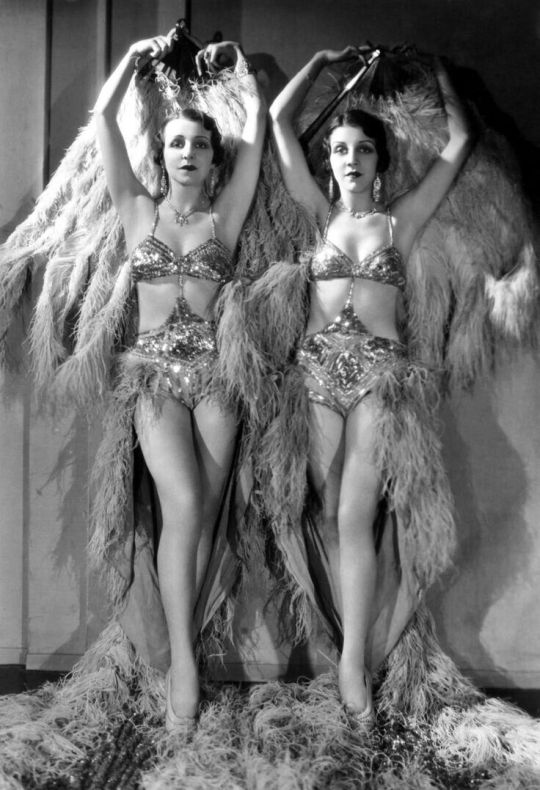
When it comes to Burlesque as a genre itself, however, it is a reflection of the social context of the time in which it is produced. In the 20th century burlesque was often a form of escapism during extreme periods of social and economic hardship like the Great Depression.
These shows portrayed performers through humorous themes and utilized social commentary that was specifically relevant to that era. Dances and shows would reflect on changing attitudes towards gender, sexuality, and societal norms which offered a space for expression that was not accessible to mainstream society.
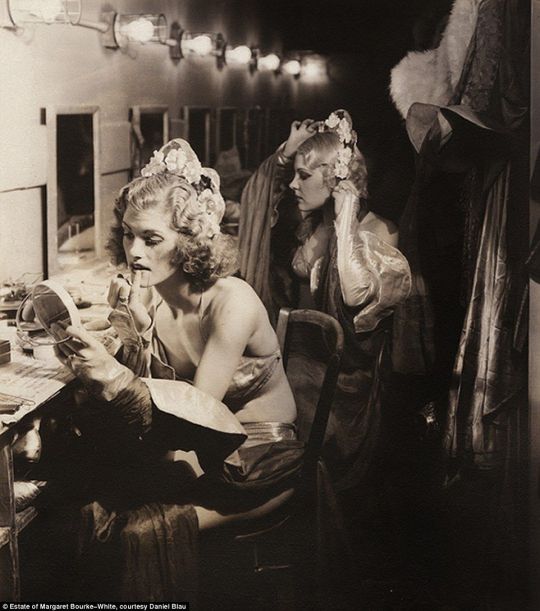
Shows in the Progressive Era (early 19th to 20th centuries) were often satirical of political figures, social norms, and cultural trends. They often involved comedic sketches and musical numbers that parodied current events, public figures, and politicians. Focusing on Los Angeles specifically in 1990s, the Velvet Hammer Burlesque was known for an avant-garde style that blended traditional elements with prevalent social commentary. These shows revolved around themes such as gender roles, sexuality, and body image, all challenging societal expectations and norms.
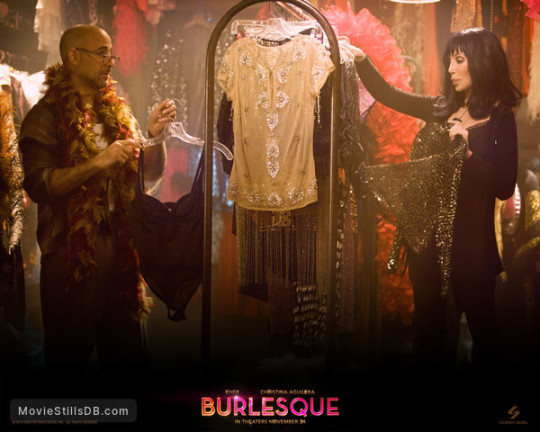
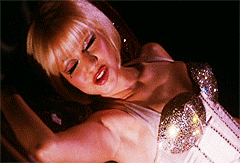
Burlesque is a time where the audience can sit back and watch while the performers can exist in an entirely different world that actively operates to critique the state of the current world through song and dance.
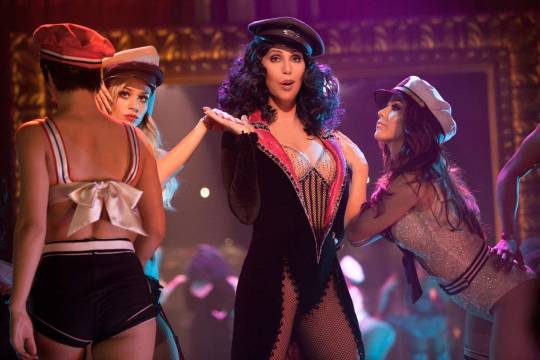
In what ways are the performance spaces separated from the narrative spaces in the film?
Unlike other musicals, the numbers within Burlesque do not drive the plot forward in a contemporary sense but rather embody a more internal and emotional significance for the character’s development throughout the films: they are just performances which physically mirror the emotional perseverance of each character. Ali's performances relate to the central message of the film rather than the moments that make it up. She performs because she needs to be on stage. And Tess, the owner of the club, performs because she needs to save the stage so the show can go on. Her song "You Haven't Seen the Last of Me" is more profound and deeply reflective of her journey with the business and what it means if it goes away. For her the performing was never her reason for keeping the place running, it was about ensuring there was a space for stars to perform.
youtube
How is spectacle integrated into the film’s narrative?
Spectacle is the essential feature of the narrative, however as described in the text the relationship between narrative and spectacle in this case is considered aggregate, meaning this relationship maintains a definite distinction between narrative and spectacle as two separate aspects of the film. The spectacle of putting on the performances is just one of the many layers of this relationship for this specific film. The performances serve as entertainment for the audience and a position of power for the characters, but these routines also work to explore thematic elements through the development of the characters.
Despite ongoing tensions among some of the girls within the club, the unifying force between them is the threat of losing the one place that makes them feel alive, that enables them to perform in the way they feel as though they were born to. In Ali's first performance "Something's Got a Hold On Me" she sings without a stage, revealing that a star can exist without a stage,but a performer relies on a stage to be a star. Once it becomes know that Ali's character can sing she gains even more recognition as someone to watch. This "star" quality separates her from the rest of the girls, playing into the Hollywood view of the more you can give, the more you'll make (and the more they'll take). A large component of the "spectacle" as mentioned in the text is the integration of the viewer as the "'internal audience" which "retreats into offscreen space', allowing the performance to be 'truly all for us'" (1982, p28). The contrast between narrative and spectacle consequently heightens the perception of both.
3:20
youtube
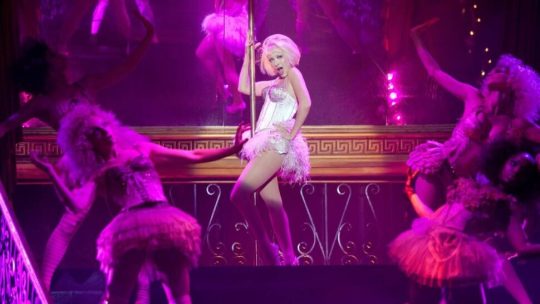
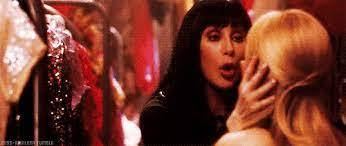
What is the role of dance and movement in relation to the film’s narrative and spectacle?
Choreographed dance numbers serve as expressions of thematic elements, emotional sequences, and interpersonal relationships. Because of the wide range of dance whether it be graceful, energetic and comedic, or sensual, a variety of emotions are conveyed through several different routines. The routines serve several purposes: transfixation of the audience through elaborate dances and costume design, a platform for the performers to therefore captivate the audience and subsequently convey thematic elements and messages through these routines, which is a compilation of the elements that make up the Burlesque performances. And to exist in opposition, though unbeknownst to audiences, Burlesque is a reflection of those who come to watch. The songs act as a mirror for society to examine themselves in a medium that is laughable but digestible. It is unironic in it's irony, leaving the audience laughing, unable to distinguish who the joke was really and truly about. The effects of the two worlds of the backstage musical Feuer discusses is this sense of "double identification" both the inclusion of the creation of the spectacle itself backstage ,and the viewing of the spectacle as the audience.
youtube
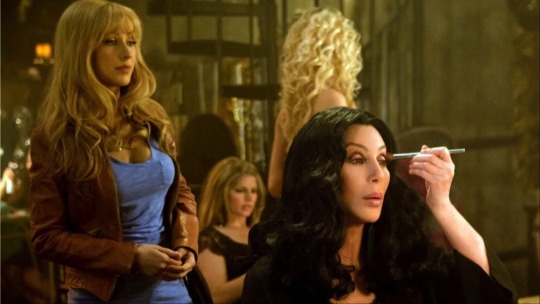

In what ways does impossibility within the film ensure the audience escapes from reality?
Within the film impossibility exists on stage so both the audience and characters live beyond the basis of reality. The dramatic costumes accompanied with music, lights, and props distort forms of reality for the characters and the audience as it creates a world of unlikely desires and imaginative ideas. This heightened reality where anything appears possible allows viewers to suspend belief and immerse themselves in this world of spectacle and fantasy. Because the characters’ main goals are to be apart of this show their desire to escape is almost more intense than those who pay to witness it. On a larger scale, the theme of impossibility and escapism is largely the central force of the film as it is designed around the main character leaving her small life behind to chase her dreams in Los Angeles.
youtube

Questions:
Are there any other musicals that offer reflection, whether satirical or not, of current social and economic circumstances?
Considering that these musicals are backstage, would you argue that the narrative separation from spectacle is what makes the musical backstage, or is it the spectacle removed from the narrative? Essentially: what is the more significant component of this type of musical, would the narratives function if the music was incorporated differently?
Burlesque is an interesting case considering masculinity, but for the other musicals, what was the gender dynamic within the film? In the text it's made clear Berkeley's dancers were mainly female as they were "spectacles all on their own," how does this impact the musicals discussed today?
How central is escapism to the narrative of your musical? Would there be a narrative without this element, or what would the story morph into in lieu of it?
@theuncannyprofessoro
20 notes
·
View notes
Text

Twitter
Video 📹 where Caitríona mentioned Geena Davis during the ATX TV Festival Outlander panel

By Chris Colin
Published May 25, 2023
Updated May 28, 2023
“Transforming Spaces” is a series about women driving change in sometimes unexpected places.
Geena Davis and her family were returning from dinner in their small Massachusetts town when her great-uncle Jack, 99, began drifting into the oncoming lane of traffic. Ms. Davis was about 8, flanked by her parents in the back seat. Politeness suffused the car, the family, maybe the era, and nobody remarked on what was happening, even when another car appeared in the distance, speeding toward them.
Finally, moments before impact, Ms. Davis’s grandmother issued a gentle suggestion from the passenger seat: “A little to the right, Jack.” They missed by inches.
Ms. Davis, 67, relayed this story in her 2022 memoir, “Dying of Politeness,” an encapsulation of the genially stultifying values that she had absorbed as a child — and that a great many other girls absorb, too: Defer. Go along to get along. Everything’s fine.
Of course the Academy Award-winning actress ditched that pliability long ago. From “Thelma & Louise” and “A League of Their Own” to this year’s coming-of-age drama, “Fairyland,” back-seat docility just wasn’t an option. Indeed, self-possession was her thing. (Or one of her things. Few profiles have failed to mention her Mensa membership, her fluency in Swedish or her Olympic-caliber archery prowess.) But cultivating her own audaciousness was only Phase 1.
Next year will mark two decades since the creation of the Geena Davis Institute on Gender in Media. When her daughter was a toddler, Ms. Davis couldn’t help noticing that male characters vastly outnumbered female characters in children’s TV and movies.
“I knew everything is completely imbalanced in the world,” she said recently. But this was the realm of make-believe; why shouldn’t it be 50/50?
It wasn’t just the numbers. How the women were represented, their aspirations, the way young girls were sexualized: Across children’s programming, Ms. Davis saw a bewilderingly warped vision of reality being beamed into impressionable minds. Long before “diversity, equity and inclusion” would enter the lexicon, she began mentioning this gender schism whenever she had an industry meeting.
“Everyone said, ‘No, no, no — it used to be like that, but it’s been fixed,’” she said. “I started to wonder, What if I got the data to prove that I’m right about this?”
Amid Hollywood’s trumpeted causes, Ms. Davis made it her mission to quietly harvest data. Exactly how bad is that schism? In what other ways does it play out? Beyond gender, who else is being marginalized? In lieu of speechifying and ribbons, and with sponsors ranging from Google to Hulu, Ms. Davis’s team of researchers began producing receipts.
Ms. Davis wasn’t the first to highlight disparities in popular entertainment. But by leveraging her reputation and resources — and by blasting technology at the problem — she made a hazy truth concrete and offered offenders a discreet path toward redemption. (While the institute first focused on gender data, its analyses now extend to race/ethnicity, L.G.B.T.Q.I.A.+, disability, age 50-plus and body type. Random awful finding: Overweight characters are more than twice as likely to be violent.)

Geena Davis accepting the Governors Award for her institute during the Primetime Emmy Awards last year. At her right are the actor Sarah Paulson, left, and the screenwriter Shonda Rhimes. Next to Ms Davis is Madeline Di Nonno, the institute’s president and chief executive. Kevin Mazur/WireImage, via Getty Images
Even when braced for it, the institute’s findings are staggering: In the 101 top-grossing G-rated films from 1990 to 2005, just 28 percent of speaking characters were female. Even in crowd scenes — even in animated crowd scenes — male characters vastly outnumber female ones. In the 56 top grossing films of 2018, women portrayed in positions of leadership were four times more likely than men to be shown naked. (The bodies of 15 percent of them were filmed in slow motion.) Where a century ago women had been fully central to the budding film industry, they were now a quantifiable, if sexy, afterthought.
“When she started to collect the data, it was kind of incredible,” said Hillary Hallett, a professor of American studies at Columbia University and the author of “Go West, Young Women! The Rise of Early Hollywood.” “This wasn’t a vague feeling anymore. You couldn’t claim this was just some feminist rant. It was like, ‘Look at these numbers.’”
Ms. Davis is by turns reserved and goofy offscreen — a thoughtful responder, an unbridled guffawer. (At one point she enunciated the word “acting” so theatrically that she feared it would be hard to spell in this article.) On a recent afternoon in Los Angeles, she took a break from illustrating the children’s book she had written, “The Girl Who Was Too Big for the Page.”
“I grew up very self-conscious about being the tallest kid — not just the tallest girl — in my class,” she said. “I had this childhood-long wish to take up less space in the world.”
In time she began to look beyond her height — six feet — to the insidious messages reinforcing such insecurity.
“Hollywood creates our cultural narrative — its biases trickle down to the rest of the world,” she said in “This Changes Everything,” the 2018 documentary she produced about gender inequity in the film industry. The documentary takes its name from the incessant refrain she kept hearing after the success of “Thelma & Louise,” and later “A League of Their Own.” Finally the power and profitability of female-centric movies had been proven — this changes everything! And then, year after year, nothing.
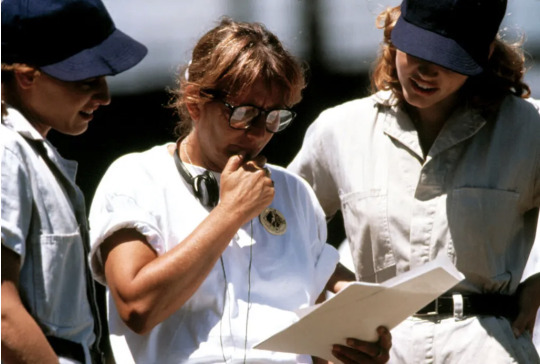
Geena Davis, right, with the director Penny Marshall on the set of A League of Their Own in 1992. Columbia Pictures, via Everett Collection
It was here that Ms. Davis planted her stake in the ground — a contention around why certain injustices persist, and how best to combat them. Where movements like #MeToo and Times Up target deliberate acts of monstrosity, hers would be the squishier universe of unconscious bias. Did you unthinkingly cast that doctor as a male? Hire that straight white director because he shares your background? Thought you were diversifying your film, only to reinforce old stereotypes? (Fiery Latina, anyone?)
It’s a dogged optimism that powers Ms. Davis’s activism — a faith that Hollywood can reform voluntarily. When she goes to a meeting now, she’s armed with her team’s latest research, and with conviction that improvement will follow.
“Our theory of change relies on the content creators to do good,” said Madeline Di Nonno, the president and the chief executive of the institute. “As Geena says, we never shame and blame. You have to pick your lane, and ours has always been, ‘We collaborate with you and want you to do better.’”
If a car full of polite Davises can awaken to oncoming danger, perhaps filmmakers can come to see the harm they’re perpetuating.
“Everyone isn’t out there necessarily trying to screw women or screw Black people,” said Franklin Leonard, a film and television producer and founder of the Black List, a popular platform for screenplays that have not been produced. “But the choices they make definitely have that consequence, regardless of what they believe about their intent.”
He added: “It’s not something people are necessarily aware of. And there’s no paper trail — it can only be revealed in aggregate. Which gets to the value of Geena’s work.”
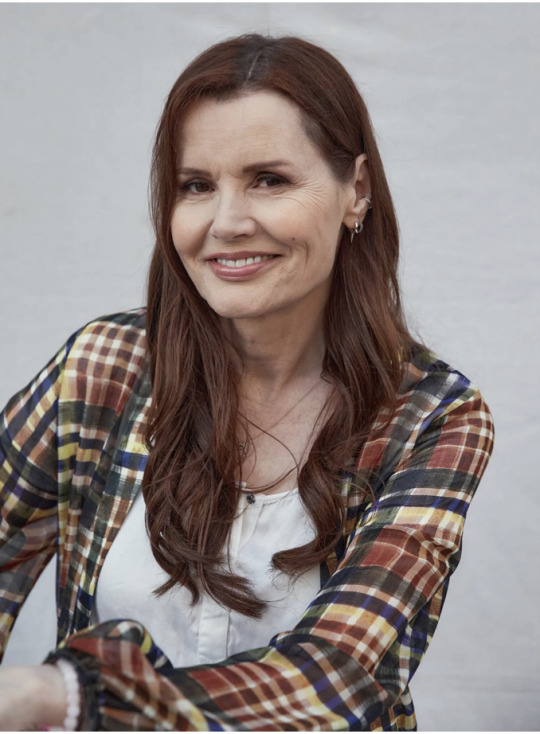
“Hollywood creates our cultural narrative— its biases trickle down to the rest of the world,” Ms Davis said in This Changes Everything, the 2018 documentary she produced about gender inequity in the film industry. Magdalena Wosinska for The New York Times
Unique to the institute’s efforts is its partnership with the University of Southern California’s Signal Analysis and Interpretation Laboratory, which uses software and machine learning to analyze scripts and other media. One tool born of that collaboration, Spellcheck for Bias, employs AI to scan scripts for stereotypes and other problematic choices. (Janine Jones-Clark, the executive vice president for inclusion for NBCUniversal’s global talent development and inclusion team, recalled a scene in a television show in which a person of color seemed to be acting in a threatening manner toward another character. Once flagged by the software, the scene was reshot.)
Still, progress has been mixed. In 2019 and 2020, the institute reported that gender parity for female lead characters had been achieved in the 100 highest-grossing family films and in the top Nielsen-rated children’s television shows. Nearly 70 percent of industry executives familiar with the institute’s research made changes to at least two projects.
But women represented just 18 percent of directors working on the top 250 films of 2022, up only 1 percent from 2021, according to the Center for the Study of Women in Television and Film; the percentage of major Asian and Asian American female characters fell from 10 percent in 2021 to under 7 percent in 2022. A 2021 McKinsey report showed that 92 percent of film executives were white — less diverse than Donald Trump’s cabinet at the time, as Mr. Leonard of the Black List noted.
“I think the industry is more resistant to change than anybody realizes,” he added. “So I’m incredibly appreciative of anyone — and especially someone with Geena’s background — doing the non-glamorous stuff of trying to change it, being in the trenches with Excel spreadsheets.”
Ms. Davis has not quit her day job. (Coming soon: a role in “Pussy Island,” a thriller from Zoe Kravitz in her directorial debut.) But acting shares a billing with her books, the diversity-focused Bentonville Film Festival she started in Arkansas in 2015 — even the roller coasters she rides for equity. (Yes, Thelma is now Disney’s gender consultant for its theme parks and resorts.)
“We’re definitely heading in the right direction,” she said. “Bill Gates called himself an impatient optimist, and that feels pretty good for what I am.”
A correction was made on May 26, 2023: An earlier version of this article misspelled the surname of the president and chief executive of the Geena Davis Institute on Gender in Media. She is Madeline Di Nonno, not Di Donno. The error was repeated in a photo caption.
A correction was made on May 28, 2023: An earlier version of this article incorrectly stated the number of Academy Awards Ms. Davis received. She won one Oscar for her supporting performance in “The Accidental Tourist,” and was nominated for a second Academy Award for “Thelma & Louise.”
How we handle corrections
A version of this article appears in print on May 30, 2023, Section B, Page 3 of the New York edition with the headline: Onscreen Sexism Hasn’t Gone Away. She Has the Data.. Order Reprints | Today’s Paper | Subscribe
Remember… if a car full of polite Davises can awaken to oncoming danger, perhaps filmmakers can come to see the harm they’re perpetuating. — The New York Times
Times source
#Tait rhymes with hat#Good times#Geena Davis Institute on Gender in Media#The New York Times#25 May 2023#Twitter#Thanks krisrose16
15 notes
·
View notes
Text
This is an older chart I had from a few years ago, but this should actually help understand what's going on right now, and why I'm focusing so much on demo and paying attention to the contents of the ad slots. Since then, demos have come down across the board considerably, as we know nothing is running a 1.0 or even close anymore, top non-events are like 0.06 these days. (also a good way to meter and remember decline)
So we're going to use these numbers as ROUGH GUIDELINES, but then we're gonna sort of. Parallel this. These were across different networks
BUT ON TO THE POINT. And figuring out more reasons you can know The Winchesters is safe as shit, even if everything under it is about to die bloody.
Check the average cost per spot, and

Now, ads are sold in that 18-49 everywhere. Due to ABC Chicanery in the 50s that just got built into the bones of the industry, ABC long ago convinced the world they were the best bc of the 18-49 demo, everyone else onboarded, and it's been the standard outside of CW for 70 years. Resultingly, 18-49 is super high value and everything else is just like. meh. we'll buy the leftovers.
I'll also be pulling data from here.
Identifying the demographics of valuable and potentially valuable customers is useful for targeting campaigns and building audiences for remarketing. For an ecommerce site, you might want to identify user groups with the highest ecommerce conversion rate or revenue. For a content-focused site, you might want to identify user groups with the highest engagement (for example, as measured by session duration or pageviews/screenviews per session).
The Age, Gender, and Interests reports all include engagement and conversion metrics. You can start from any of these reports to build a picture of your high-value customers.
In this example, the Age report shows that 18-24 and 25-34-year-olds together make up the majority of users, but the 25-34 segment contributes the most revenue and has the highest conversion rate.

If you drill in to that age group to see how it breaks down by gender, you see less disparity in the volume of sessions (still 3:1 in favor of male), but a much larger disparity in revenue (58:1). The conversion rate is 2:1 male to female, but the revenue per transaction is 9:1 in favor of male users.

This isn't Supernatural, btw. If you break down SPN's age skew, the male and female demos looked level by the end, and that demo itself has 2 women heads to 1 male head. And now spnwin has higher women demo anyway, and they're showing the highest retention rate while older users drop off. So currently, 18-49 women are just dominating Spnwin, but there's still a strong presence of men. So you get women-skewing ads but still a healthy mix of gender neutral stuff guys can like, like marvel.
You can venture through that link to dig deeper, like which other nonclassical demos (technophiles, nerds, etc) also bring in the best revenue. Yes, we can and will see and figure that out.
You can use the same kinds of analysis to find low-value audiences that you used to find your high-value audiences: rather than look for high revenue and conversion rates, you simply look for the opposite. Once you’ve identified those low-value customers, you can then exclude them from seeing your ads. (*this is largely in digital distribution, like through the app; they can't individually target your TVs.)
So anyway, this is how ads break down. Then we go to this post someone helpfully tortured themselves so I don't have to.
Basics:
TW: iPad, iPhone, Marvel, Disney, Amazon Prime Video young romance films, Jeep car ads, 4 Kohls/Old Navy/Walmart ads, lots of ads with Millennials.
Walker: iPhone, Shingles vaccine (for those over 50), Medicare health plans, Olay wrinkle cream, Ford car ads, 2 Kohls ads, a mental health ad, some ads with Millenials.
Windy: iPad, Disney, Shingles vaccine, flu shot, dry skin cream, probiotic, ads with grandkids, 8 Kohls/Old Navy/Walmart/grocery store ads, no car ads.
Okay so I've helpfully highlighted. Bold is like. Big buku buck buyers. Italic is like, they're decently high end, it's not friggin disney or amazon, but I mean. They're solid big slot buyers. Crossout is "over 50, low monetization, health or other packaging not slotted 18-49" that are residual ad buy on lower value space. Beyond that, you see which has a few millenials and which is trusted with none. ipad and disney you can still pitch at old people and go "HEY CHRISTMAS IS COMING BUY FOR YOUR KIDS, THEY'LL LIKE THIS MOVIE, IT HAS YOUR FAVORITE 90S ACTOR VOICING A DOG, YOU'LL LIKE IT TOO"
But ultimately just look at the aggregate. TW doesn't even have SPACE for garbage ads. Meaning those slots drive up all the more.
Now look at that first chart again.
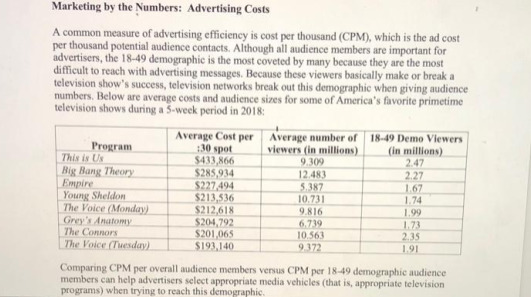
so ok, we know these numbers are inflated. But let's play a game. What shows are the highest demo here, which are the lowest demo, and how much do they cost.
See even that isn't always equal. The connors space is worth half as much as This Is Us, even with near similar audience. But we're gonna mark that as a breakout exception. Kinda like Winchesters. Winchesters HAS no extra space so competitors and buyers literally had to compete on those slots, inflating that show's value.
But now that I've broken down things like how to drill in and find the right advertisers, or mentioned risking a rare high ad in a low slot, you can see, there's almost calculated risks in that, and they know they'll hit at least a FEW target eyes, but they spend less for the slot.
So since Winchesters is running 0.2+ in +7, and Walker is running about 0.12 in it, we're gonna compare that between the high yield ones (let's just use BBT instead of This Is Us, to be Fair) at the top and the other lower running shows.
For example;; Empire looks weak in demo compared by what it's surrounded with!! what gives! ... well, uh. Look at the audence size. It's less than half what's around it but pulls well above half value. If you doubled that demo on magic audience powers that'd be above a 3.0. So that's actually a very dense collection of exactly the eyes you're looking for. It's highly monetizable. You are targeting EXACTLY the fuckin people you want.
...why the connors is so low I genuinely don't know. There's gotta be some logic there that's whistling over my head specific to that product.
You will see though, none of these actually portray the 0.2> 0.12 drop because that's almost half. The closest drop you see there is BBT to Grey's Anatomy which is STILL a hit show. 286K to 205K difference, between 2.27 to 1.73. That's what, a reduction of less than 25%? Try almost 50%. We'll be GENEROUS and say Walker is running 60% of Winchesters. 172K/spot even if we round up. And that's if we don't further value/devalue these shows based on their digitals, while CW is bundling packages together and Winchesters is pulling 3x Walker in the app. What's 1/3 of 286k--94K? if we round up i think. Cool, so if we give Winchesters that 286K for its Cdigitals, Walker's digitals are worth like. 94k. So then these bundle in averages and you get like. 286K/slot vs 133/slot if we're just. Roughing out this math with these averages.
[stares into the camera in the value gap]
So then we come down to Nexstar talking about what's monetizable. Ok. Well it's not working in the app, it's not working live and it's not working in DVR, it doesn't have international travelability. Can anyone tell me why they would offer these products more than 1M/licensing fee? There are typically four commercial breaks in a half-hour show, each lasting two minutes. This equates to a total of 16 30-second commercials.
So let's say. 16 x these numbers. 16 x TW, 4.576 Million in ads. 16 x Walker, 2.128M in ads. Keep in mind CW ads actually pull lower than these, so let's cut out about 25% from these numbers. Winchesters about 3.43M, Walker about 1.596M/ep. Live and app digitals they earn from.
OK. So. We'll just round. 3.4M vs 1.6M.
Now, Nexstar is talking about capping their licensing fee at 1M, with exdceptions to shows based on their performance and monetization, eg, is it worth it for them to put more in.
If walker is worth 1.6M to Nexstar per episode, and costs about 3M/episode to make especially by next year, can anyone tell me why Nexstar is gonna give them more than 1M? If they even upped it to 1.5 they'd be breaking even, not making money. Who's gonna pay the other 2 million? Is CBS gonna invest it and hope for mass licensing to pay it back? When it has REALLY low travelability outside of the US because nobody else gives a fuck about cowboy cops?
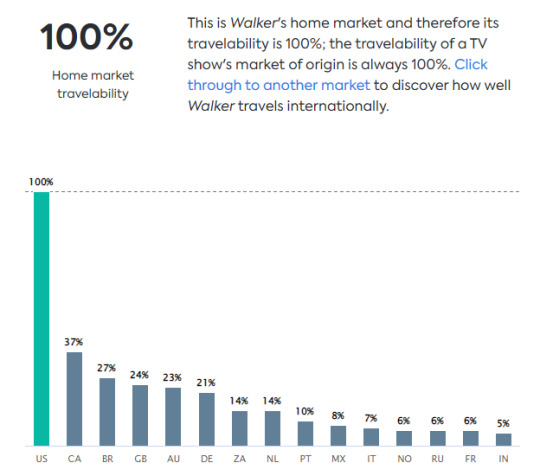
Who the fuck are they gonna sell it to, for how much? about 20 eps at about 2 million cost to CBS is 40 million. Where do you foresee Walker pulling 40million licensing out of this in the international markets? They could get a little in canada, brazil, great britain and AU, but already low volumes. It's a third as likely to draw interest in its top cross-the-border, and one fourth to one fifth in the next four markets. Where does CBS make its money back if it foots the bill.
CBS *might* opt to try to argue for a renancel "for its fans" which means "to be able to wring out every dollar, package and boost a final season, and prepare bulk marketing of final season DVDs and stuff for a final boom". And then pay off the balance. Because Nexstar sure fuckin wont.
Now let's look at Winchesters. It isn't even in a fuckton of markets yet, doesn't have bulks of seasons already available to watch, etc. But it's still locally pulling 3x digitals AND has some international demand as other markets open up and/or buzz about it.
We know in this figure we're saying it's worth about 3.4 M.
We know it is co produced by WB, CBS, and Chaos Machine. While walker only has CBS to fill in the bill Nexstar won't, Chaos Machine can opt to finance *them fuckin selves* if for some reason WB doesn't see fit to internationally market it and use that as a reason to suggest. Let's look at the Winchesters international markets while it's barely even in any:

it's not until markets 6 and 7 we hit 1/3 value, and markets 8-13 that hit that "1/4th to 1/5th" area. Several are around half or above. Average the first 3 after the US and that's 3 50% travelability zones. These are zones that will want it, and pay good money for it.And again, we don't even have many markets actually open. This is just the fuckin general demand.
So we know for a fact TW is worth WB investing in, but the question is, will it even have to?
3.4M vs 1.6M. If Walker gets about 1M from nexstar, they're looking for a ~roughly 33% margin which seems fair. About a third profit.
So let's take a third out of 3.4 2.278, rounding we'll just say 2.3. So nexstar could give Winchesters about 2.3 million and still make the same PERCENTAGE of profit as Walker, which actually constitutes *far more profit*
At its current age, Winchesters costs about 2.5 to produce. So either: minding the raw volume of profit they get, they can chunk in that extra couple thousand. Or, if they're still gonna be cheap asses, that remaining 200K or so can be first opted to WB who could easily find the value in it, then to CBS coproducing, and then ultimately to Chaos Machine, Jensen and their financiers. each source could put in 67K, which is pennies for them, mere pocket change, and nobody fuckin flinches.
(this also fails to divide out any other expenses for nexstar like payments to owners and royalties and shit, so realistically their profit margin is much slimmer, take that down to another third of themselves.
So that 600K profit per ep for walker on 1M licensing fees if someone else made up the other millions, that looks more like 200K still for Nexstar. But that 1.1million of Winchesters divided down to a third is still almost 400K/episode. After paying out those costs and fees and all the shit associated.
So even if Walker was reduced to 1M/ep licensing by Nexstar, Nexstar still barely sees shit back from it. Whereas if they gave Winchesters 2.3M they'd make twice as much out of it still on raw profit than they would giving Walker 1M.
There's just. There's no competition here yall.
Don't even get me started on Windy. That shit was dead on arrival. The only way it survives is to try to employ its lower budget, murder Walker, move it into Walker's place, assume it pulls the boosted numbers from timeslot, and hope it keeps the old audience. This IS a small potential because its CW app views are doing about 2x Walker, which is why it wedged in a FEW solid ads, even if still skewing meh. But it's really not enough to argue to save it.
That meeting Jared had was no doubt "either wrap it up, talk to CBS about financing your final season, or decide if you can import everybody to Windy, you've got a few months to come up with an answer."
by the way, this ENTIRE THING is working on the assumption that The Winchesters' digital value etc and its overpacked high end buyers *aren't* driving up the real estate the same as Last Of Us, which was worth double its competitors for that space. Otherwise enjoy 8.6M profit.
17 notes
·
View notes
Note
This isn't strictly about vol 3 but what you said about how female and poc characters not always used to the fullest is incredibly important. I think a lot of people forget race and gender don't get left at the door when people approach writing characters and how their stories/arcs are plotted out. Even big name actors and actresses have talked about both gender and racial disparities in different aspects of the film industry. It wasn't a coincidence that it took until 2018 to get a film like Black Panther or 2017 to get Wonder Woman. Both of these strides forward are less than a decade old. Gamora was the first female lead played by a woc in the mcu and despite how things have been going now, she didn't start out an accessory to the male leads story. She was a leader of her own. She was the second most prominent character in IW and part way through the film it all came crashing down. Vol 3 finished it off by not dealing with anything that happened and made some things worse.
Taking all of this in it's easy to see that we often take steps backwards even as we stride forward. Who's in charge of writing, directing and other factors count towards the treatment of characters particularly the less they're like Steve Rogers and the more their like Natasha or Gamora.
Vol 3 left all the characters alive so yeah Gamora is around to come back and we know Zoe isn't entirely closed off from maybe returning. However that doesn't guarantee her return or that she would be treated well. I love her character and she has the most potential for further development but marvel can be hit or miss and like it or not Gunn kind of screwed her over. Unless someone as dedicated as the Gamora fans I currently see sticking up for her is put on the job I wouldn't be shocked to see her get turned into a caricature with only 1 personality trait.
yuuuuup i pretty much agree with all this anon. with the way gamora's story ended up going, i think it's realistic to expect that a middle aged white man wasn't exactly the most qualified to tell that kind of story, especially if he already has blinders on due to having a clear, self-admitted favorite character of the ensemble (rocket). like it or not, either gunn had no interest in doing gamora's story justice or he was simply not equipped to, and either way, gamora lost big time
4 notes
·
View notes
Text
Unraveling the Tapestry: The Complex Portrayal of Women in Media

In a world where media shapes our perceptions, it's time we unravel the tapestry that weaves the portrayal of women. From silver screens to glossy magazines, it's crucial to recognize the multifaceted nature of this portrayal and the impact it has on our collective consciousness. Join me as we dive deeper into the complex depiction of women in media, shedding light on both the progress made and the challenges that still lie ahead.
Beyond the "Damsel in Distress": Breaking Stereotypes Historically, women in media were often confined to passive roles, perpetuating the stereotype of the "damsel in distress." However, recent years have witnessed a significant shift. Films and TV shows now feature female characters who challenge societal norms, displaying strength, resilience, and intelligence. Characters like Wonder Woman, Rey from Star Wars, and Offred from The Handmaid's Tale serve as powerful symbols of women reclaiming their narratives.
The Double-Edged Sword: Sexualization vs. Empowerment One contentious aspect of women's portrayal in media is the fine line between sexualization and empowerment. While some argue that embracing sexuality can be empowering, others contend that objectification still persists. Analyzing music videos, advertisements, and even video games, we observe a nuanced interplay between female empowerment and the perpetuation of unrealistic beauty standards. It is crucial to encourage diverse representations that celebrate a range of body types, ethnicities, and abilities.
Invisibility No More: Amplifying Marginalized Voices Women from marginalized communities have long been underrepresented or misrepresented in media. However, as our society becomes more inclusive, we witness a growing demand for authentic stories that reflect diverse experiences. Trailblazing projects like "Pose," "Never Have I Ever," and "Gentefied" explore the narratives of LGBTQ+ women, women of color, and immigrant women, offering a refreshing departure from the mainstream.
The Glass Ceiling: Behind the Scenes While we critique the portrayal of women in front of the camera, it's essential to shine a light on the gender disparities behind the scenes. Women continue to face significant obstacles in the film industry, with limited opportunities as directors, writers, and producers. By championing and supporting female voices in these roles, we pave the way for more nuanced and authentic portrayals of women in media.
Unveiling the Marketing Machinery: Consumer Influence The media landscape is undeniably shaped by market forces. Advertising plays a crucial role in perpetuating gender stereotypes and beauty standards. By becoming savvy consumers, we can challenge these narratives. Social media movements like #NoMakeup, #EffYourBeautyStandards, and #WomenInSTEM encourage women to embrace their authentic selves and defy conventional expectations, promoting inclusivity and self-acceptance.
As we step back and examine the portrayal of women in media, we uncover a tapestry of progress, setbacks, and untapped potential. By demanding more diverse representation, challenging stereotypes, and amplifying marginalized voices, we can weave a future where women's stories are truly reflective of their diverse realities. Let's unravel the threads of the past and stitch together a more intriguing and empowering future for all.
#rights#human#women#gender#sterotypes#no makeup#female#social#media#influence#comsumer#marketing#love#inkdsythe
2 notes
·
View notes
Text
instagram
Breaking the Glass Ceiling: Priyanka Chopra's Fight for Pay Parity
Priyanka Chopra Jonas' journey to achieving pay parity reflects the systemic challenges faced by women in Hollywood. During her appearance on "The View," she candidly shares her disbelief at the acceptance of her request for equal pay. Reflecting on the pivotal role of Jennifer Salke, the female head of film and TV for Amazon Prime, Chopra Jonas raises important questions about gender dynamics in decision-making positions. Would her plea for equal compensation have been met with the same enthusiasm if the studio leadership were predominantly male?
Chopra Jonas' success in securing equal pay not only marks a personal milestone but also serves as a catalyst for broader change within the industry. By advocating for parity, she paves the way for future generations of female actors to demand fair compensation for their talents. As she aptly puts it, "Women have to be in decision-making positions because it changes other women's lives."
This victory resonates with the broader conversation surrounding gender pay gaps in Hollywood. Ellen Pompeo's revelation about her salary disparity on "Grey's Anatomy" and Chopra Jonas' own experiences in Bollywood highlight the pervasive nature of this issue across different entertainment industries. However, Chopra Jonas' success story offers a glimmer of hope and serves as a testament to the power of persistence and advocacy in achieving gender equity.
#FeministFrontline#EqualityInAction#FeministVoices#EmpoweredWomen#WomenInFilm#EqualRepresentation#FilmEquality#EqualPay#Instagram
0 notes
Link
Explore the ongoing conversation surrounding pay inequality in the entertainment industry, as discussed by acclaimed actresses Olivia Colman and Taraji P. Henson. Uncover their candid revelations and the broader implications for gender equality in Hollywood. Shedding Light on Wage Disparity In recent years, prominent figures in Hollywood have been vocal about the glaring discrepancies in pay between male and female actors. Olivia Colman and Taraji P. Henson are among those who have openly discussed their experiences with wage inequality, shedding light on an issue that continues to pervade the film and television industry. Olivia Colman's Candid Confession During a recent appearance on CNN's The Amanpour Hour, Olivia Colman candidly addressed the issue of pay disparity in Hollywood. The Oscar-winning actress expressed frustration over the gender-based wage gap, emphasizing that male actors often command higher salaries despite outdated justifications rooted in audience draw. Insights into Colman's Experience Despite her acclaimed performances and accolades, Colman revealed that she has personally encountered instances of pay inequality. Reflecting on her career trajectory, she acknowledged that her earnings pale in comparison to what her male counterparts would command in similar roles, highlighting a staggering 12,000 percent pay difference in one instance. Taraji P. Henson's Perspective Colman's sentiments echo those expressed by Taraji P. Henson, who shared her struggles with wage disparity in a candid interview with The Hollywood Reporter. Henson lamented the persistent challenge of negotiating fair compensation, underscoring the systemic barriers faced by Black actresses in particular. The Impact on Future Generations Both Colman and Henson underscore the broader implications of pay inequality beyond their careers. They emphasize the importance of advocating for change to ensure that future generations of actors, especially women and minorities, are not subjected to the same systemic inequities. The Call for Systemic Change As voices like Colman's and Henson's continue to resonate within the industry, there is a growing call for systemic change to address pay disparity in Hollywood. Advocates argue that fair and equitable compensation is not only a matter of economic justice but also a crucial step toward fostering diversity and inclusion in entertainment. FAQs Q: Why is pay disparity still prevalent in Hollywood? A: Pay disparity persists in Hollywood due to entrenched biases and outdated beliefs about the marketability of male versus female actors, as well as systemic inequities that disproportionately affect women and minorities. Q: How do actresses like Olivia Colman and Taraji P. Henson advocate for change? A: Actresses like Colman and Henson use their platforms to speak out against pay disparity, share their personal experiences, and advocate for systemic reforms within the entertainment industry to ensure fair and equitable compensation for all actors. Q: What can be done to address pay inequality in Hollywood? A: To address pay inequality, Hollywood must implement transparent salary structures, conduct regular pay audits to identify disparities, and actively support initiatives that promote diversity, equity, and inclusion across all levels of the industry.
#Advocacy#diversity#entertainmentindustry#genderequality#Hollywood#inclusion.#OliviaColman#OliviaColmanandTarajiP.Henson#paydisparity#systemicchange#TarajiP.Henson#wagegap
0 notes
Text
Critical Film Analysis: Eve's Bayou (1997)

In Black Spectatorship: Problems of Identification and Resistance, Manthia Diawara hones in on the racial inequalities present within the Hollywood film industry. Because Hollywood and other major media outlets are so heavily dominated by whiteness, there are a wide range of films that speak to the white experience. This creates an obvious disparity between the viewing experience had by white people, and those who don’t see themselves accurately reflected on screen. Diawara speaks on the idea of spectatorship, which encompasses the perception, interpretation, and social context of the respective viewer. Spectatorship changes as the spectators lived experiences shape their understanding of the world. Diawara notes that there is a pleasure in identification through spectatorship. Those whose identities are reflected on screen, are able to achieve a higher sense of enjoyment through television. This, however, is not commonly afforded to Black spectators, who receive only a sliver of representation. “And at the level of spectatorship, the Black spectator, regardless of gender or sexuality, fails to enjoy the pleasures which are at least available to the white male heterosexual spectator positioned as the subject of the films' discourse”(771). Black people, time and time again, are forced to bare witness the misinformation that their lives are given in film and television. Because of this, the term “resisting spectator” emerged. The idea of resistant spectatorship implies that viewers have the ability to reinterpret, reimagine, and resist on-screen portrayals, rather than passively accept them. Viewers are made to actively question, challenge, and resist the ideologies presented in the movie in order to reimagine widely perpetuated, though harmful, norms. Black people who do not resonate with the painting of Blackness in television, embraced the ability to critique, and even create. As this oppositional form of spectatorship grew, as did creative experts’ efforts to reflect this resistance on screen. Diawara states that “resisting spectators are transforming the problem of passive identification into active criticism which both informs and interrelates with contemporary oppositional film-making. The development of Black independent productions has sharpened the Afro-American spectator's critical attitude towards Hollywood films” (775). The emergence of all Black productions worked to combat Black spectators’ desensitization to wrongful depictions of Blackness, and urge positive representation to become the new norm. Eve’s Bayou is a 1997 film that practices being unapologetically Black through its all Black cast, and its devotion to exploration into Black girlhood and family life, through a lens unfiltered by whiteness.
Eve’s Bayou (1997), is an American horror/drama written and directed by Kasi Lemmons. The film follows 10 year old Eve Batiste and her family in their affluent Creole-American community in 1960s Louisiana. The story is shown through Eve’s perspective, as she witnesses events that start to unravel the secrets and complexities of her family. Being told from the lens of Eve, a young Black girl, makes the film a pertinent example of the rejection of the white gaze in media. In bell hooks’, Black Looks: Race and Representation, hooks engages with the concept of “the gaze”, particularly in the context of Black women. She introduces the notion of the "oppositional gaze," which is a gaze that challenges and resists the dominant, often white, male gaze. A gaze that is both male and white can not accurately capture the experience of those outside of themselves, especially that of Black women. Black women have been subjected to being represented only through the gaze of others, often having to act out stereotypical tropes on camera. Eve’s Bayou, however, allows the narrative to be constructed by actual Black people, bringing more truth to the Black experience than predominantly white films do. The film opens with shots of the the town in which Eve’s family lives in, paired with her own narration, explaining the origins of the land. She states that the town was named after an enslaved woman named Eve, who saved the life of General Jean Paul Batiste, and was freed, and granted their piece of land in return. The setting of the film itself is already indicative of how it aims to shed a different and less stereotypical light on Black life. Oftentimes within media, especially during the late 20th century, Black people were portrayed as being limited to the slums of urban environments, and prosperous Black communities in rural surroundings went unrepresented. This scene contradicts the way of life that the white gaze has created for Black communities, and places Black bodies in a setting where they are traditionally not ‘supposed’ to be. The first glimpse we get of the characters is at a party in the Batiste’s home. The mise-en-scene work to highlight the elevated status of the Batiste family, and their extended community. There is dancey background music, their home is nicely decorated, and everyone is dressed in finery. Not to mention, all of the attendees are Black, displaying a range of skin tone, hair color, gender, and age. The film strays away from tokenism, and embraces the variety of Blackness through its characters.
Though Eve’s Bayou is centered around the supposed dazzling Batistes’, the film hones in on the dark, uncomfortable, and sometimes supernatural reality of the family, unraveling a tale of mysticism, secrets, and complexities of human relationships. The film is a Southern Gothic, which is substantiated by its taking place in the Louisiana bayous, on land that was once used for enslavement. Lemmons masterfully employs elements of voodoo and folklore, interwoven with psychological horror, to construct a narrative that is both eerie and thought-provoking. Unlike other predominantly Black horror films, Eve’s Bayou does not use racism and poverty, as the terror for all Black people. The film's horror is deeply rooted in the personal and familial struggles of the characters, transcending the racial boundaries seen in traditional, hegemonic plot lines. The Batiste family must grapple with consequences of choices made, and the haunting specters from the past, neither of which rely on their Blackness. Eve’s Bayou serves as a poignant example of a story told from the Black female gaze, one that focuses on the intricacies of human life, but through bodies that are Black.
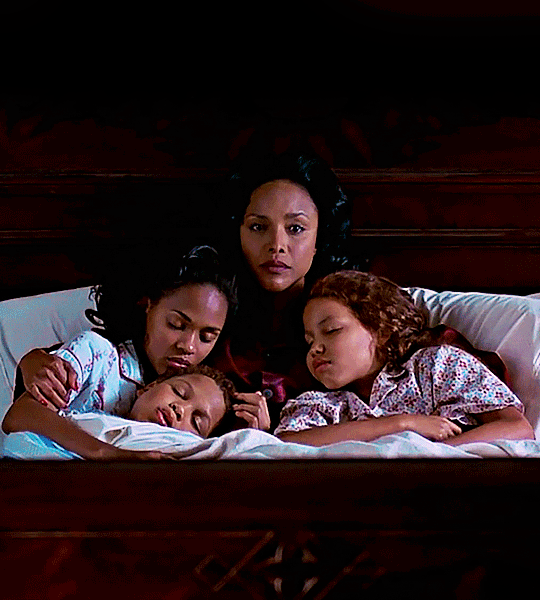
Works Cited:
Hooks, Bell. Black Looks: Race and Representation. Routledge, 2015.
“Black spectatorship: Problems of identification and resistance: Manthia Diawara.” Black American Cinema, 2012, pp. 217–226, https://doi.org/10.4324/9780203873304-20.
0 notes
Text
Jake Seal Black Hangar Explains The Influence of Film Festivals on Global Cinema

In the vibrant tapestry of global cinema, film festivals emerge as pivotal platforms that not only celebrate artistic endeavors but also shape the very contours of the film industry. Jake Seal Black Hangar, delves deep into understanding the profound influence of film festivals on the global cinematic landscape.
A Confluence of Cultures and Narratives
Film festivals serve as melting pots where diverse cultures converge, allowing for a rich exchange of narratives, techniques, and perspectives. Whether it's the Cannes Film Festival in France, the Sundance Film Festival in the United States, or the Venice Film Festival in Italy, these events spotlight films that challenge conventions, champion unique voices, and offer fresh insights into pressing global issues. Jake Seal emphasizes, "Such festivals act as a mirror, reflecting the socio-cultural dynamics of our times while fostering dialogue and understanding."
Nurturing Emerging Talent
One of the most significant contributions of film festivals is their role in nurturing emerging talent. Filmmakers, actors, writers, and technicians worldwide converge at these events, offering a fertile ground for collaboration and learning. Jake Seal Black Hangar Studios states, "For budding filmmakers and artists, festivals provide a platform to showcase their work, gain invaluable feedback, and forge connections with industry stalwarts." This nurturing environment often paves the way for groundbreaking cinematic endeavors, propelling fresh voices into the limelight.
Catalysts for Change
Beyond the glitz and glamour, film festivals serve as catalysts for change, advocating for social justice, environmental consciousness, and cultural inclusivity. Many festivals curate thematic sections that spotlight films addressing pertinent issues such as racial inequality, gender disparity, and environmental degradation. Jake Seal Black Hangar Studios observes, "By spotlighting such films, festivals amplify voices that might otherwise remain unheard, fostering conversations that drive societal change." In this regard, film festivals transcend their role as mere entertainment platforms, assuming a more profound responsibility in shaping public discourse and catalyzing transformative action.
Economic Implications and Industry Trends
From an economic perspective, film festivals wield considerable influence, catalyzing tourism, promoting local businesses, and driving industry investments. Cities and regions hosting renowned festivals witness a surge in visitors, generating significant revenue and fostering cultural exchange. Jake Seal Black Hangar Studios notes, "The economic implications extend beyond the festival dates, with cities leveraging their association with cinema to bolster tourism, attract investments, and promote cultural tourism." Furthermore, film festivals offer a glimpse into emerging industry trends, spotlighting innovations in storytelling, technology, and distribution models. Industry stakeholders keenly observe festival selections, identifying promising trends, and adapting their strategies accordingly.
Fostering International Collaboration
Film festivals serve as epicenters for international collaboration, facilitating co-productions, distribution deals, and cross-cultural exchanges. Filmmakers and industry professionals from different countries converge at these events, exploring collaborative opportunities, and forging partnerships that transcend geographical boundaries. Jake Seal Black Hangar Studios highlights, "The collaborative spirit fostered at film festivals transcends linguistic, cultural, and geographical barriers, paving the way for cinematic endeavors that resonate with global audiences." Such collaborations enrich the cinematic landscape, infusing diverse perspectives, and fostering a spirit of global solidarity and cooperation.
Conclusion
In conclusion, film festivals wield significant influence in shaping the global cinematic landscape, fostering cultural exchange, nurturing emerging talent, and advocating for societal change. Jake Seal Black Hangar Studios underscores the pivotal role of festivals in celebrating artistic excellence, promoting international collaboration, and driving industry innovation. As we navigate an increasingly interconnected world, film festivals serve as beacons of creativity, resilience, and transformative potential, reaffirming their indelible impact on global cinema.
#entertainment#studios#film#filmindustry#jakesealblackhangarstudios#jakesealblackhangar#blackhangarstudios#production#movies#camera
0 notes
Text

Rock of Ages
Rock of Ages is a 2012 jukebox musical styled as a comedic film involving the interweaving storylines of several artists trying to make it big in the rock music scene. The film is built around 1980s rock featuring songs from bands like Styx, Journey, Bon Jovi, Europe, and more.
What are the social aspects within the film’s narrative that align with the film’s songs?
The film is set in 1987 Los Angeles. As mentioned in the text "rock and roll, the first new wave of pop music, appeared then as a label which certainly seemed to be new to the mainstream, but its success has to be understood along social lines: white appropriation of Black music, marketing youth lifestyles, and encouraging teen consumerism" (7).

This wave of pop music was categorized by the social base it addressed. In Rock of Ages a small town girl Sherrie Christian (Julianne Hough) meets city boy Drew Boley (Diego Boneta) on the Sunset Strip as they try to launch their musical careers. The entire soundtrack utilizes rock from the 80s which was an extremely controversial period of music for its time leaving audiences heavily divided. This disparity between supporters and haters of the music is depicted in the film pinning rock listeners and churchgoers against each other.

Building up to the 80s and lasting throughout the decade, rock was criticized for explicit lyrics, themes of rebellion, and references to drugs use, violence, and sexual content. This created widespread paranoia among parents, religious groups, and conservative organizations about the impact of listening to this music. There were certain bands like Black Sabbath and Iron Maiden that raised concerns for a spread of Satanism. Rock, more so than anything, was known for challenging traditional social norms and values like gender roles and sexual morals. Artists like Prince and Madonna are known for these kinds of provocative lyrics and performances.
youtube
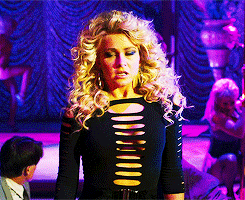
The songs within the film are emblematic of a period of rebellion, a genre dedicated to challenging norms and establishing its own realm of music. Songs like "I love Rock and Roll," "Wanted Dead or Alive," "I Want to Know What Love is," and "Hit Me With Your Best Shot" are all emblematic of societal reflections imposed onto the characters within the narrative. Catherine Zeta-Jones' character Patricia Whitmore is the film's main antagonist in her disdain for rock music. But quickly, through seduction of a famous musician, she is quickly swayed away from hatred and into a total state of enamor.
The music also serves to explore the faults of the rock industry as well by exploring all avenues of glitz, glamor, and obstacles.
How do the historiographies of previously recorded songs inform audience relationships with the musical’s narrative and performers?
As aforementioned, the history of rock not only permeates the soundtrack but the narrative as well. Though paranoia surrounding rock music came from conservative and religious groups fearing and overtaking of Satanists, many famous rock musicians and bands struggled with substance abuse. The star of the film, Stacee Jaxx (Tom Cruise) is a mirror into the lives of former rock stars struggling with the weight of their fame. Throughout the film he goes in and out of sobriety, though for the most part he remains absurdly intoxicated especially while performing.

The text discusses how music integrates itself with culture by influencing attitudes, fantasies, politics, and listening communities (7) and that it was much "easier to describe rock's style negatively - to describe what it wasn't" (8). Because rock was new, it was perceived to be threatening, especially because it was powerful. In the film specifically the characters revolve their lives around the music as if their existence depended on it.
Each character has their own relationship to the industry which are uniquely expressed through different rock artists and bands. Whilst picketing Stacee Jaxx and rock music in general, Patricia Whitmore (Zeta-Jones) tells the rock fans to hit her with their best shot, superbly vocalizing Pat Benatar's epic 1980 single.
youtube
When Sherrie struggles to make it big she lands herself a job in a strip club where she and the rest of the dancers harmonize alongside Mary J. Blige for a version of "Anyway You Want It."
youtube
But even those who fear the music at the beginning of the film learn to love it by the end.
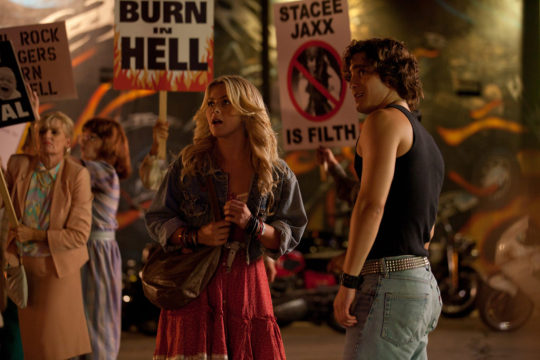
What musical genre/style drives the film’s score, and how does the genre/style (re)define the film as a musical?
Rock music is the SOUL of this film. It is the only music included which I think really defines the heart of the narrative and the power behind the battle of fighting for the music, as well as everyone's individual career. This influence is in the HAIR, their CLOTHES, their MAKEUP, and their connection to each other.
In order to examine the genre of the film that is inspired by the music, I want to just showcase what these artists looked like and how they performed their art.
Jon Bonjovi.
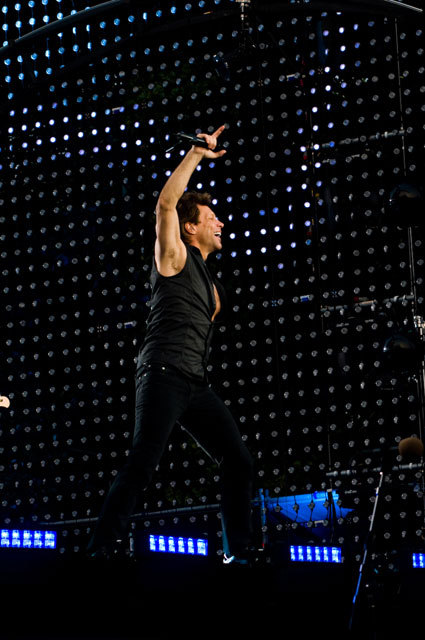
The vision herself, Pat Benatar:
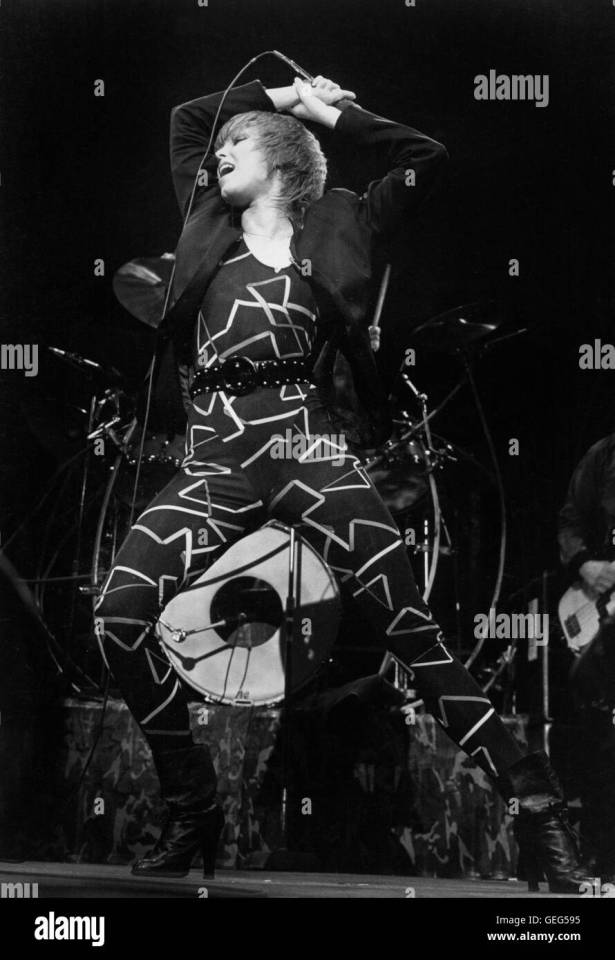
Whitesnake:

Def Leppard at their first concert:

To really capture this energy wouldn't have been possible for the film for what it intended to be as the songs have a bit more of a pop influence for the film, which I would argue makes the music more digestible in order to reach a larger audience. However, I believe keeping the songs in the same style would have created a more realistic tone for the film.
@theuncannyprofessoro
17 notes
·
View notes
Text
Reader
ADUKIA, A., et al. (2023). What We Teach About Race and Gender: Representation in Images and Text of Children’s Books. The Quarterly Journal of Economics. 138(4), p.2225–2285. [Online]. Available at: https://doi-org.ezproxy.herts.ac.uk/10.1093/qje/qjad028 [Accessed: 8 December 2023].
Adukia et al. developed computational tools and integrated Artificial Intelligence (AI) to analyse text and images converted into data using influential children’s books from the last century as a source material. This was done in order to better understand racial and gender inequalities that persist in society. Their results found that diverse representation was slowly improving, but there was still a large disparity between mainstream identities and underrepresented genders and ethnicities.
Children’s media reaches beyond books to other visual media such as games, films and television. Representation in children’s media can alter children’s perception and treatment of others and poor representation can enable prejudices to persist. Understanding this is vital for pre-production artists when considering the choices directly available to them when designing diverse and intersectional characters, as character roles have real world consequences through subconscious bias.
ARVA, E. L. (2008). Writing the Vanishing Real: Hyperreality and Magical Realism. Journal of Narrative Theory. 38(1), pp.60-85. [Online]. Available at: https://www.jstor.org/stable/41304877 [Accessed: 4 January 2024].
Writing the Vanishing Real compares key theories of realistic representation with magical realism’s fantastical ‘re-presentation’ of reality in simulating affect related to trauma. Magical realism is an ontological duality existing beyond the realistic and ‘faded’ components of media. Arva defines and argues for its validity in a post-modern world through using key theoretical frameworks on ‘reality’ to analyse text and visual imagery rich with magical realism, whose depictions enhance the affect of trauma that is otherwise difficult to narrate in realistic terms.
Though an older text, magical realism is still applicable to my practice as Arva discusses key theories about the depiction of reality and magical realism in images, and the prominence of fictional text analysis directly relates to narrative tools. Narrative is a vital component of film and games, which often aims to engage the viewer emotionally and empathetically; fantastical or abstract portrayals can sometimes more realistically express psychological effects people experience, allowing for a more empathetic viewing experience.
GALL, D. et al. (2021). Embodiment in Virtual Reality Intensifies Emotional Responses to Virtual Stimuli. Frontiers in Psychology: Cognitive Science. 12(1). [Online]. Available at: https://doi.org/10.3389/fpsyg.2021.674179 [Accessed: 5 January 2024].
This article consists of a study by Gall et.al to determine the level of embodiment experienced through Virtual Reality (VR) and synchronous and asynchronous external stimulation. The participants experienced a far greater amount of virtual embodiment (measured by the sense of self-location, agency and body ownership), with synchronous stimulation, as well as experiencing heightened emotional responses while in the state of greater embodiment. The study results also hypothesise that a state of reduced embodiment could cause depersonalisation.
This study has massive implications for several sectors including the gaming industry. A version of character embodiment currently exists through the use of motion-capture controls enabling the player’s virtual hands to move synchronously with their own, however, once technology has advanced enough to implement said stimulation to a more accurate and greater degree, the immersiveness of VR will reach new heights. Concept art can prepare fair representations of diverse characters to utilise the emotional effect of current and future virtual embodiment states to reduce bias and intolerance.
HABERL, E. (2021). Lower Case Truth: Bridging Affect Theory and Arts-Based Education Research to Explore Color as Affect. International Journal of Qualitative Methods. 20(1). [Online]. Available at: https://doi-org.ezproxy.herts.ac.uk/10.1177/1609406921998917 [Accessed: 9 January 2024].
Harberl uses arts-based, qualitative research methods coupled with feminist and existing affect theories around art and linguistics to analyse the presence of affect in education through a study of seventh grade pupils in the USA. Her research model was unique through the inclusion of vulnerable writing and an accompanying visual representation of the affective experience. Harbel used key feminist theory to encourage vulnerability and eliminate the hierarchy of power present in education. Harbel’s findings were surprising as the pupils chose to illustrate their affective experiences with colour and abstract forms.
While the study has a focus of affect and education, the key theories and findings around this work have a wide range of application. The emotive power of colour theory is already prominently in use in the media. Visual study results such as this one can help enrich existing practices for more affective and empathetic content. As a concept artist, colour theory is a key component for accurately conceptualising intended emotions and visual narratives.
LATIKKA, R. et al. (2023). AI as an Artist? A Two-Wave Survey Study on Attitudes Toward Using Artificial Intelligence in Art. Poetics. 101(0). [Online]. Available at: https://doi.org/10.1016/j.poetic.2023.101839 [Accessed: 14 January 2024].
Latikka et al. conduct a longitudinal research survey on public perception of the use of Artificial Intelligence (AI) in the arts. Their choice to use the theoretical SDT framework as research parameters was informed by other surveys on AI. While there were several categories included in the survey, a key result found a direct correlation between positive feelings toward AI and feelings of autonomy and relatedness of AI in participants' daily lives, but overall, less positively than in other sectors such as medicine. There were also participants that felt AI-produced art was “strange” and “cold”.
This extremely recent (published December 2023) study is timely when considering the rapid development of AI and its use in every sector. The games and films industries are already adopting the use of AI within their pipelines to meet the demand of media consumption. While there are ongoing debates on the ethicality of AI art, understanding the public reception of AI art is important when incorporating it into media products.
LOMAS, T. (2019). Positive Semiotics. Review of General Psychology. 23(3), pp.359 - 370. [Online]. Available at: https://doi-org.ezproxy.herts.ac.uk/10.1177/1089268019832 [Accessed: 4 December 2023].
Positive Semiotics aims to reharmonise the relationship between psychology and semiotics as both fields are necessary to understand the phenomenon of media manipulation. Positive Semiotics, influenced by Positive Psychology, is about the intersection of semiotics and well-being, and the study of the positive effects of sign-systems. Lomas creates an analytical formula using Pierce’s semiotic framework as well as the five criteria of Pawelski’s normative and non-normative desirability, a defined aspect of positivity, as a scaling sign-system.
Lomas’ theory is important when considering the impact of semiotics in media, particularly when it intersects representation. As a media creator, being mindful of myth is vital, but creating a sign-system that can positively influence others is ideal. With that goal in mind, Lomas’s formula can help me be intentional when planning my work, although, as Lomas mentions, I need to be aware that normative (in a cultural context) and non-normative desirability is viewer subjective.
MASANET, M., VENTURA, R. & BALLESTE, E. (2022). Beyond the “Trans Fact”? Trans Representation in the Teen Series Euphoria: Complexity, Recognition, and Comfort. Social Inclusion. 10(2), p.143 – 155. [Online]. Available at: https://doi.org/10.17645/si.v10i2.4926 [Accessed: 8 December 2023].
Fair representation of LGBTQ+ people in media can contribute to the creation of prejudice-reducing pedagogies. Masanet et al. analyse the representation of the character Jules, a transgender woman, in the series Euphoria to explore fairness in the show’s trans representation. They determined that Euphoria contained concepts of complexity, recognition and comfort which were a good start in leaving behind a stage of imperfect representation. The analysis was also able to highlight specific examples of overcoming simplistic and stigmatised portrayals.
Understanding the power multi-layered representations can have in fighting rising discrimination against the LGBTQ+ community makes me, as a practitioner in the pre-productive stages of media, partly responsible for ensuring the nuances of good representation are sought after. Analyses such as this one can help me be aware of what constitutes good representation and avoid stigmatic pitfalls that can lead to stereotyping or greater harm.
RICO GARCIA, O.D. et al. (2022). 'Emotion-Driven Interactive Storytelling: Let Me Tell You How to Feel'. In: MARTINS, T., RODERIGUEZ-FERNANDEZ, N., REBELO, S.M. (eds) Artificial Intelligence in Music, Sound, Art and Design. EvoMUSART 2022. Lecture Notes in Computer Science, vol 13221. Cham: Springer. pp 259–274 https://doi-org.ezproxy.herts.ac.uk/10.1007/978-3-031-03789-4_17
The user-interactivity that creates unique experiences in games has inspired more interactive storytelling in films. Rico Garcia et. al created a specialised electroencephalography (EEG) emotion-based recognition system to aid in delivering, through the computing abilities of Artificial Intelligence, tailored content to enable the directors’ emotional intent of the film to pass onto the viewers in a seamless, interactive viewing experience. The directors gave predefined instructions to deliver and enhance sequences for their desired emotional outcomes through colour and contrast, and alternative performances by actors.
The system developed by Rico Garcia et al. is an amazing start to a viscerally-tailored interactive experience. Ethical use of this system could reach end-users in both the games and films industries once the technology has been streamlined. In the immersive future of extended reality, being aware of current research and future technological developments can prime a concept artist for making full use of the breadth of their design work by creating templates to further the ends of ethical emotional delivery.
THIEL, F. J. & STEED, A. (2022). Developing an Accessibility Metric for VR Games Based on Motion Data Captured Under Game Conditions. Frontiers in Virtual Reality: Virtual Reality and Human Behaviour. 3(1). [Online]. Available at: https://doi.org/10.3389/frvir.2022.909357 [Accessed: 5 January 2024].
Thiel and Steed develop a metric to measure the mobility required to interact with different Virtual Reality (VR) games. Once developed, the computational metric could streamline accessibility information systematically across game suppliers without human curation, supplying the relevant information to disabled consumers before purchase. The computational metric is informed by key research into five characteristics of movement: impulsiveness, energy, directness, jerkiness and expansiveness. Although a limited study for now, they test their metric in measuring participants' mobility in current VR games.
This study highlights key issues with accessibility in VR games. A metric is a wonderful start to informing patrons before they purchase, but hopefully accessibility can improve in the future with better alternative controls available in VR games. Concept artists can conceptualise interactive-based character movement and can work with UI artists and programmers to create adaptive experiences that do not feel secondary to more conventional VR gameplay.
THON, J. N. (2019). ‘Transmedia Characters: Theory and Analysis’. Frontiers of Narrative Studies. Volume 5. (Issue 2). pp.169-175. [Online]. Available at: https://www.degruyter.com/document/doi/10.1515/fns-2019-0012/html [Accessed: 27 October 2023].
Transmedia Characters: Theory and Analysis suggests ways to analyse and design characters that are individually depicted in multiple forms of media. Thon emphasises analysis on how characters are influenced by the conventions of their specific media and relationships through other media. The discussions on principles like minimal departure and transmedia character templates provides practical advice for retaining characteristics while being considerate of adjustments required by the aforementioned conventions.
Thon also somewhat offers assurance for artists through the principle of a limited degree of consumer charity which allows for differences in character representations due to media requirements. Thon retains a focus on transmedia characters over figures while clarifying both terms, an important consideration for character concept artists when negotiating client briefs to help them understand the degree of traits or elements being kept consistent. I found Thon’s theory of particular interest to me as a generalist concept artist, with a love for character design, to use as a guide for migrating transmedia characters.
0 notes
Text
Female-centric films have comparatively lower budgets
Female-centric films have comparatively lower budgets
Filmmaker Alankrita Shrivastava highlighted the persistent gender disparities in the film industry, emphasizing that there is a prevailing mindset that women-centric films face challenges in achieving the same level of success as their male-centric counterparts. The director of acclaimed projects like Lipstick Under My Burkha, Made in…
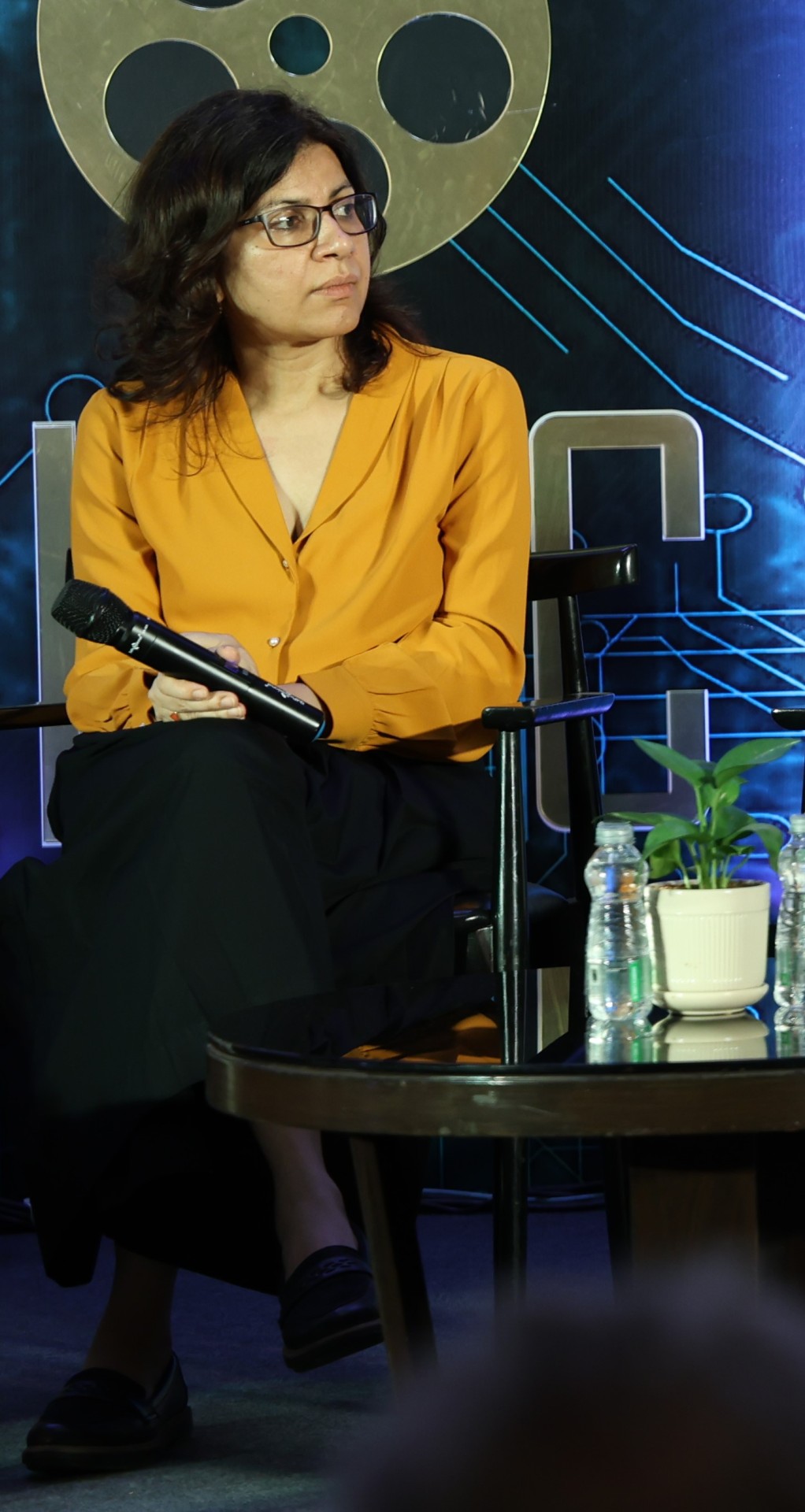
View On WordPress
0 notes
Text
Cinema has always been a powerful tool capable of both reflecting and shaping cultural values, perspectives, and societal trends. From its inception to the present day, films have exerted a tremendous influence on society and culture. In this article, we will explore how movies reflect and influence the socio-cultural landscape.The Reflective Power of Cinema:Movies have a unique ability to reflect the values, beliefs, and norms of the society in which they are created. They serve as a mirror, capturing the essence of a particular era. This reflection is evident in various aspects:Historical Context: Historical films transport viewers to different time periods, offering a glimpse into the past. These films provide insights into the lifestyles, fashion, and societal structures of the era they depict.Social Issues: Many films tackle contemporary social issues, shedding light on matters such as racial discrimination, gender inequality, and economic disparities. These cinematic portrayals often spark discussions and drive social change.Cultural Diversity: Cinema showcases diverse cultures and perspectives, promoting understanding and appreciation of different ways of life. Films set in various regions and featuring multicultural casts help bridge cultural gaps.Technological Advancements: Advances in film technology reflect the progress of society. The evolution from silent films to high-definition 3D productions mirrors the rapid technological advancements of the 20th and 21st centuries.The Shaping Influence of Cinema:While films can reflect culture, they also possess the power to shape it. This influence is evident in several ways:Social Commentary: Filmmakers often use their art to comment on societal issues. Thought-provoking films can raise awareness, challenge existing norms, and encourage viewers to question the status quo.Cultural Trends: Iconic films can spark fashion trends, popularize catchphrases, and even influence the music industry. The cultural impact of movies is especially pronounced when they capture the spirit of their time.Influence on Behavior: Certain films have been known to influence behavior and public perception. For example, movies addressing environmental issues can inspire eco-consciousness, while those depicting heroic acts can encourage altruism.Globalization: Hollywood and other major film industries play a significant role in spreading American culture worldwide. This can lead to both positive cultural exchange and concerns about homogenization.Conclusion:Cinema's role in reflecting and shaping culture is undeniable. Films provide a window into the past, a commentary on the present, and a glimpse into possible futures. They have the power to challenge societal norms, inspire change, and shape the way we perceive the world around us. As we continue to embrace the art of filmmaking, it's crucial to recognize and harness its potential to contribute positively to our ever-evolving cultural landscape. Read more here https www xnxx com big ass
0 notes
Text
Breaking Stereotypes: Saniya Iyappan's Strong Stand for Women's Empowerment
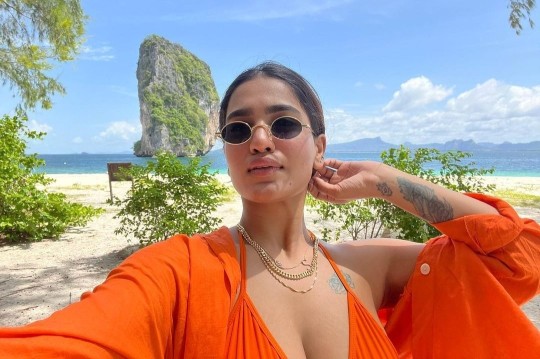
Saniya Iyappan, the talented actress from the South Indian film industry, is not just known for her acting skills and dance prowess but also for her strong stand for women's empowerment. In an industry that has been traditionally male-dominated, Saniya has been vocal about breaking stereotypes and advocating for gender equality. In this article, we explore Saniya Iyappan's unwavering support for women's empowerment and the impact she has made in challenging societal norms.
Championing Gender Equality
Saniya Iyappan is a strong advocate for gender equality and has consistently voiced her support for women's rights. She believes in dismantling stereotypes that limit women's potential and hinders their progress. Through her public statements and social media presence, she encourages women to break free from societal expectations and pursue their dreams, irrespective of gender barriers. Saniya's commitment to gender equality serves as an inspiration for women across all walks of life.
Promoting Body Positivity
In an industry that often places undue emphasis on unrealistic beauty standards, Saniya Iyappan has been a vocal advocate for body positivity. She firmly believes that beauty comes in all shapes, sizes, and forms, and rejects the notion that one has to conform to a certain idealized image. Saniya promotes self-love, acceptance, and embracing one's unique individuality. Her positive messaging resonates with many women who have struggled with body image issues and empowers them to embrace their bodies just as they are.
Supporting Women in the Entertainment Industry
Beyond her personal advocacy, Saniya Iyappan actively supports and uplifts women in the entertainment industry. She recognizes the gender disparities that exist and is committed to creating opportunities for other talented women. In interviews and social media interactions, she acknowledges the contributions of her fellow female actors, directors, and technicians, breaking the notion that women are in competition with each other. By promoting collaboration and solidarity, Saniya creates a supportive environment for women to thrive in the industry.
Inspiring Young Girls
Saniya Iyappan's strong stand for women's empowerment has made her an inspiration for young girls all over. She serves as a role model for those who aspire to break free from societal norms and pursue their passion, irrespective of gender expectations. Through her success and advocacy, she shows young girls that they are capable of achieving anything they set their minds to.
Challenges and Pushback
While Saniya's advocacy for women's empowerment has received widespread acclaim, it has also faced some resistance and backlash. Some critics argue that discussions around women's empowerment often exclude other marginalized genders and fail to address intersectional issues. It is important to acknowledge and address these concerns to ensure a more inclusive and comprehensive approach to gender equality.
Conclusion
Saniya Iyappan's strong stand for women's empowerment is commendable. Through her advocacy, she challenges societal stereotypes, promotes body positivity, supports women in the entertainment industry, and inspires young girls to reach for their dreams. Saniya's efforts contribute to the broader movement for gender equality and empower women to break free from the limitations imposed on them. Her influence extends beyond the realm of entertainment and serves as a catalyst for social change.
Sources:
https://www.onmanorama.com/entertainment/entertainment-news/2021/01/17/saniya-iyappan-mollywood-actors-fandom-journey.html
https://timesofindia.indiatimes.com/entertainment/malayalam/movies/news/saniya-iyappan-talks-about-her-passion-for-social-media/articleshow/88232607.cms
0 notes